![]()
BMW R1100/1150 Black Hole Spyder Exhausts 
R1100RT / R1150RT Exhaust Systems
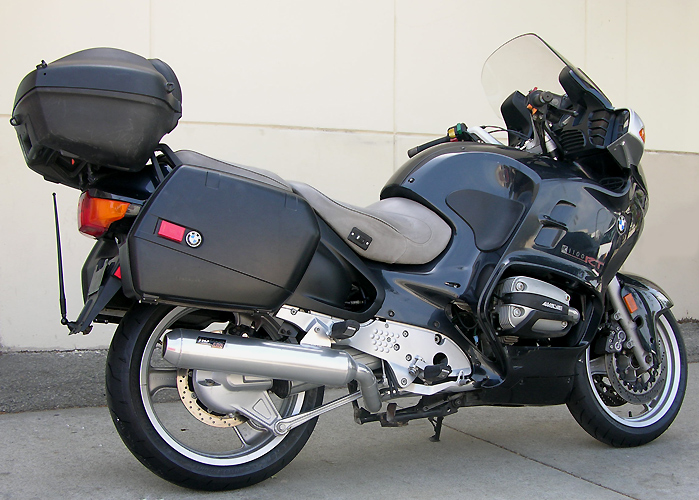

Pro Stock Spyder Technology
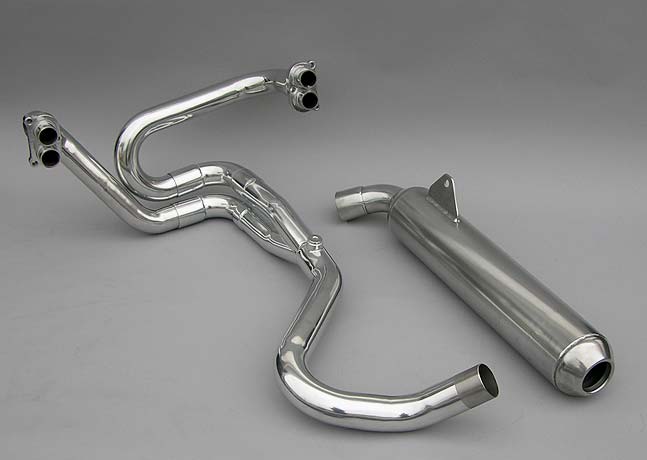
Early R1100RT three bolt and later R1150RT two bolt systems. 1 3/4" (45mm) primaries instead of the OEM 38mm ones which restrict the bike's potential. Sophisticated hand made merge collector with our LSR Black Hole sound-cancelling technology. Nothing to pack, or repack, ever. We offer two versions, one quieter than the other...Sport or Touring (quieter).
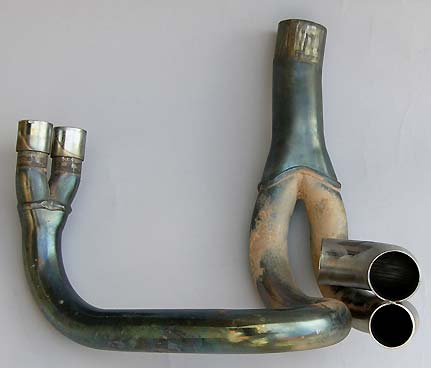
We cut up a R1100RT header to show the difference in tubing sizes. The oem 38mm primary tubes are the limit in the system. The large bore (99mm) pistons are happier with a larger cross sectional area. Look at late, very expensive, R series race bikes and you'll see what we mean. If we put 38mm (1 1/2") primary tubes on any Harley, which has a similar bore size, it would kill the top end.
Small tubes kill power..Mickey Rourke
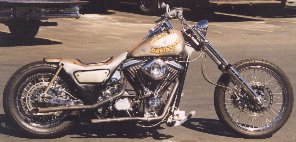
We know because we did just that for Mickey Rourke's Harley in the movie "Harley Davidson and the Marlboro Man". The sound guys wanted the pipes to "crackle" so we made some 1 1/2" primary tubes. They foleyed in other sounds anyway. We built larger pipes for the bike after the movie was made. 45 or so crank horsepower is just too much for the smaller tubes. Dave Fournier built the bike. We got to run from the cops while testing it. Power in 1st and 2nd gear then it died in 3rd, strangled by the exhaust.
After we got away, the cops tracked us down after backtracking and, through a process of elimination, found our shop. Less than amused, they advised us to notify them in the future if we were testing "movie bikes".
We use 45mm or 1 3/4" primary tubes for the R1100 series.
Race Quality Slip Joint Design

Slip joint design eliminates cracking from thermal expansion and contraction as well as bike vibration. Laser cut and machined exhaust ports with machined spigots to keep exhaust flow at a high speed. Oxygen sensor port. Silver Ceramic, Black Ceramic (dual coat) or SS Titanium (dual coat) finishes.
When assembling the parts put a light coat of Permatex 598B silicone in the slip joints or any gasket silicone compound that is compatible with O2 sensors.
Ceramic Finishes
In case you are interested, here's the drill for ceramic coating. Bend the parts. Pattern cut the parts. Polish the sub parts. Tig weld and hand fit the merge collector. Tig weld the assemblies in sub fixtures. Drive the parts 65 miles one way to the coater. Coater bakes the parts, then cleans the parts to remove any internal residue. Coater blasts the parts, cleans the parts again and applies a sealer coat and lets the parts dry. Coater then masks and sprays the parts with silver ceramic and bakes the parts for a second time. Coater then tumbles the parts in large vats to burnish (harden) the surface.
In the case of Black ceramic or SS Titanium ceramic the freshly coated silver ceramic parts get lightly abraded and sprayed and baked for a third time. We then drive another 130 miles to pick up the parts and drop off the next batch. Sort of expensive.
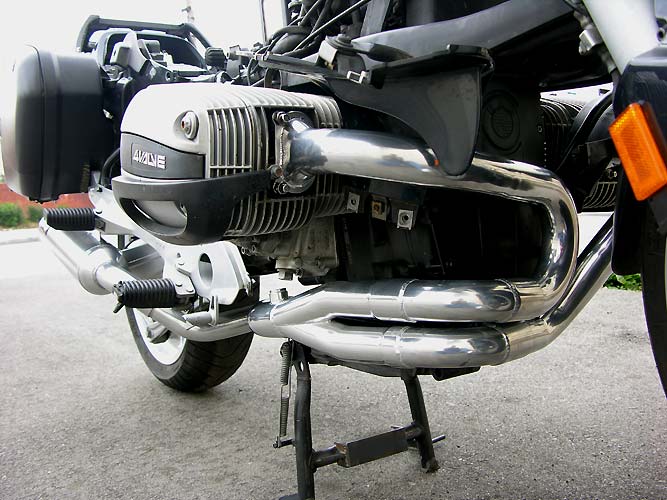
Right side exit completely frees left side for tire servicing. Pipe clears center stand and all RT fairing bits and pieces. Clever BMW owners will notice a modified center stand. It's modified for our 240 hp turbocharger system...The LSR 2-1 Black Hole Spyder Exhaust for the R1100RT/R1150RT does not require any center stand modification. This particular 2000 R1100RT is going turbo.
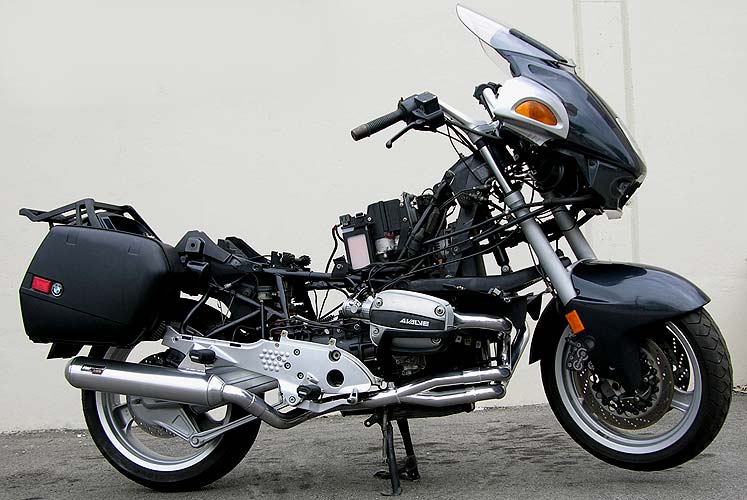
Exhaust clears the saddle bags and will not transfer heat to their contents. You can't see things with the bodywork in place so we left it off. The bike is going turbo anyway and had to have the airbox removed. In fact we removed the entire rear section of the bike as we had to install our new turbo clutch.
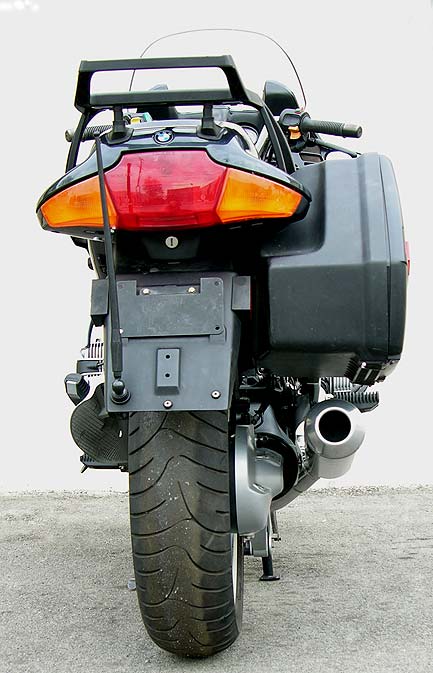
Business end of a R1100RT LSR 2-1 Black Hole Spyder exhaust. A complete race-designed system that is quiet for touring or screwing with Goldwings in the twisties.
BMW R1100/1150RT Inlet System
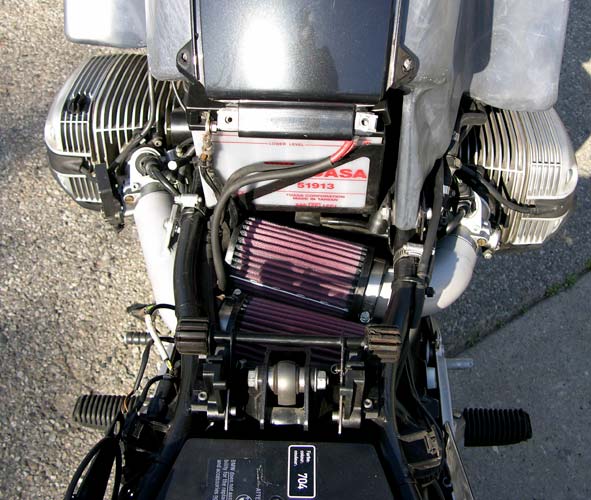
Our Zero Restriction inlet system with large capacity K&N Filters for the R1100RT and R1150RT. About 560hp worth of air filters or more than 5x the oem system. Both left and right inlets have their own individual filter. Machined and anodized aluminum. On the R1100 and R1150RT's we provide a fail-proof mount system. We also provide new O-Rings for your throttle bodies.
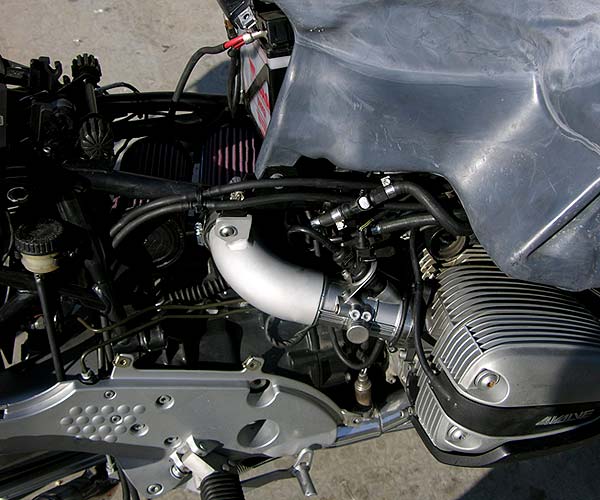
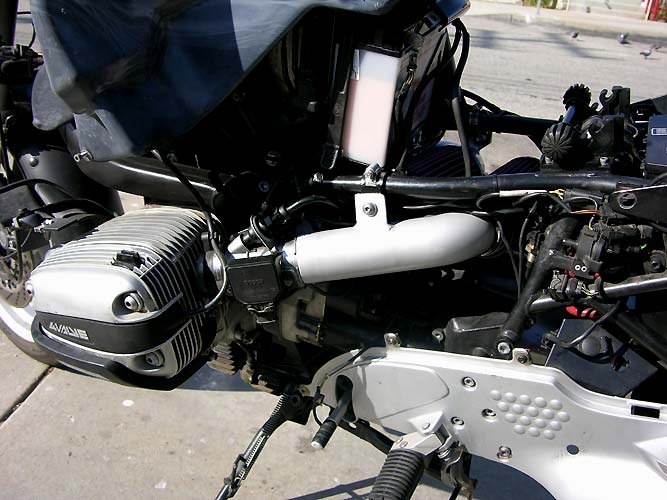
The goal is to increase the airflow per unit of time to speed transitions and to free up the inlet tract so it does not hold back our exhaust system. The left tube is designed longer than the right tube.
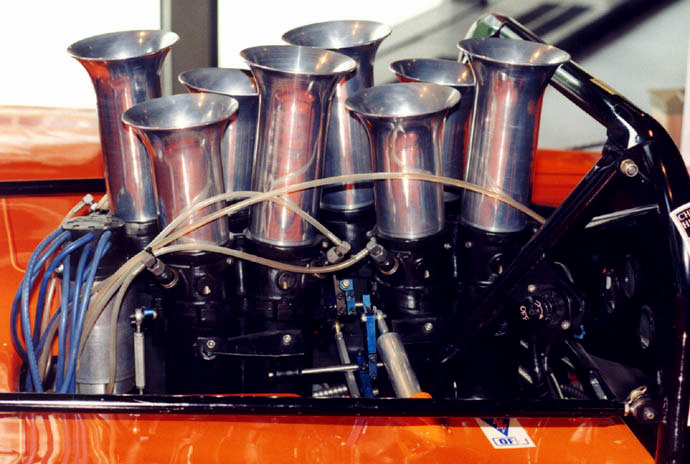
We have our reasons.
Real World Dyno 60 to 80 MPH
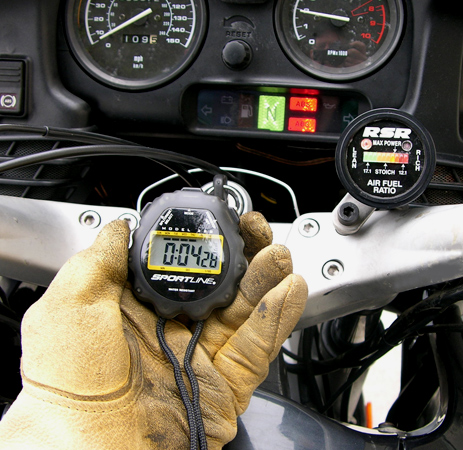
Where the rubber meets the road. The last time we checked that was where you actually ride. You're zipping along at 3500 rpm or less and pull out to pass or you roll on against another bike in high gear. That's the real test. We have a eddy current magnetically braked dyno that has all sorts of factors and calibrations we can load into it, but it's the real world that counts.
Here's some magazine published numbers for the years of the R11RT Series for 60 to 80 high gear roll-ons: R1100RT 5.1 seconds; R1150RT 4.9 seconds; and the R1200RT 4.3 seconds. These times are sort of logical as the R1100RT started out with 90 hp @ 7250 RPM; the R1150RT 95 hp @ 7250 RPM; and the R1200RT 110 hp @7500 RPM. 7250 to 7500 RPM is interesting but it's more than twice the RPM you do your roll-ons at.
We took a 2000 R1100RT and added a 200 lb rider, 2/3 of a tank of gas, saddle bags, and a 33L top case and did our standard 60 to 80 mph roll-on testing on a level stretch of road without the aid of wind. No drag racing tricks like taking off the mirrors or lowering the windscreen, backing off the brake pucks, or crouching down on the tank. With the R1100RT Black Hole Spyder Exhaust, stock injectors, and our Zero Restriction Inlet System the 60-80 roll on times averaged out to 4.28 seconds, a 17% improvement over the stock time of 5.1 seconds.
The illogical conclusion would be we got the 110 hp the R1200RT has, i.e. up 20 horsepower from the stock R1100RT 90 hp. Wrong. All you can say is we dropped our 60 to 80 times .8 seconds or just as quick as a R1200RT. Real world gains in torque. Hp is (Torque x RPM) /5252. We have means of making it faster.
Fuel Rails and Fuel Pressure

The BMW R1100RT (and all other R series) deadheads the fuel at the injector i.e. fuel does not flow past the injector as do on the K-Series three and four cylinder designs. The regulator is built into the fuel rail, is not tied to manifold pressure, and is set, in this case, at 43.5 psi (3Bar). Since we turbocharge these bikes we must reference fuel pressure 1:1 with manifold pressure otherwise fuel pressure would drop as boost rises. We make a Billet Bosch Fuel regulator that is referenced 1:1 with manifold pressure to replace the oem system.
Under very hot conditions the oem fuel rail can heat soak leading to an erratic (lean) idle because fuel is not flowing past the injector feed port and "cooks" in the u-shaped feed line. For our turbos we re-route the fuel flow, running the fuel directly to the right injector, then to the left injector and then off to the adjustable Bosch Billet, manifold-referenced regulator. To do this, we machine special injector caps with inlet and outlet ports. This system is available for our exhausts.

We rear mount the regulator for easy side panel access. In the case of normally aspirated applications we raise the fuel pressure about 3 psi to 46.5 psi or 3.2 Bar. If you leave the fuel rail at 3 Bar (43.5 psi) and install our Zero Restriction inlet system and Spyder exhaust the bike will be leaner on cold start and will pop more on closed throttle decel. Some people change the Motronic chips to richen things up paying $400.00 or more for the recalibration. We can supply calibrated ecu chips for certain models for $250.00. In the case of turbos we optimize the fuel delivery with the oem injectors at 3.2 Bar and use the Billet Bosch regulator to maintain this pressure relative to manifold pressure even at 30 psi of boost.
Note: The glycerin-filled gauge is only used for testing.
Faster
Raising the fuel pressure to 46.5 psi and resetting the Throttle Position Sensor to .390 VDc resulted in 60-80 times of 4.0x seconds on the average or about a 1.1 second advantage over the published stock time of 5.1 seconds, a 22% improvement.
Putting in a 3.5 Bar K-Series regulator will cause the bike to run too rich. Don't do it.
R1100GS / R1150GS Black Hole Spyder Exhaust Systems
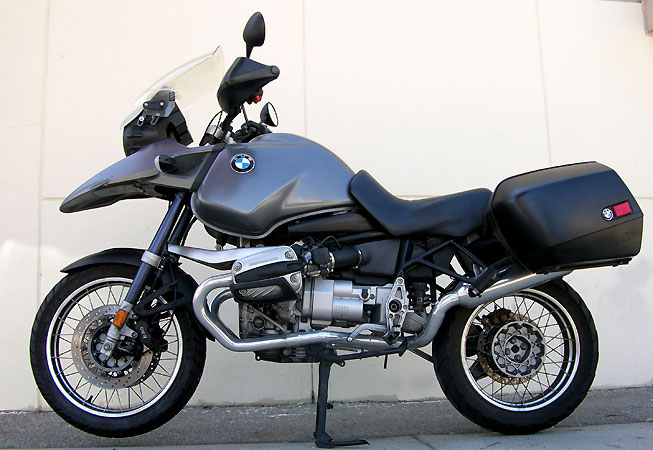
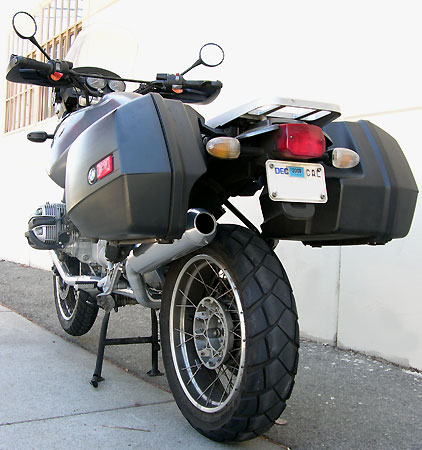
We have completed testing on R1100/1150GS Series exhaust systems and will be posting information on fuel system upgrades. Exhaust system clears saddle bags, side and center stands and has excellent ground clearance. Bike is way way faster than before. We offer both Sport and Touring (quieter) baffles. Available in the three ceramic finishes: Silver (shown); Black Ceramic dual coat; and SS Titanium dual coat.
BMW R1150GS Black Hole Spyder exhaust shown in Silver Ceramic finish.
R1100S Black Hole Spyder Exhaust Systems
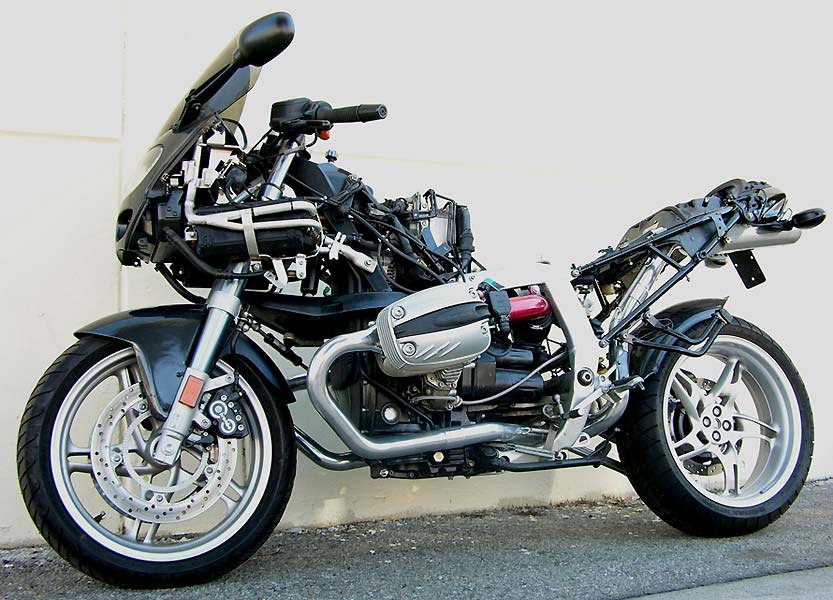
Finally, a no-compromise exhaust for the Ducati-esque R1100S, a bike that looks the part but falls a bit short in the power department. We are offering some real gains in torque and power and a level of quality that is commensurate with the bike's innovative engineering. Fuel system upgrades accompany the exhaust system's increased potential.
Installation instructions are provided in a pdf format.
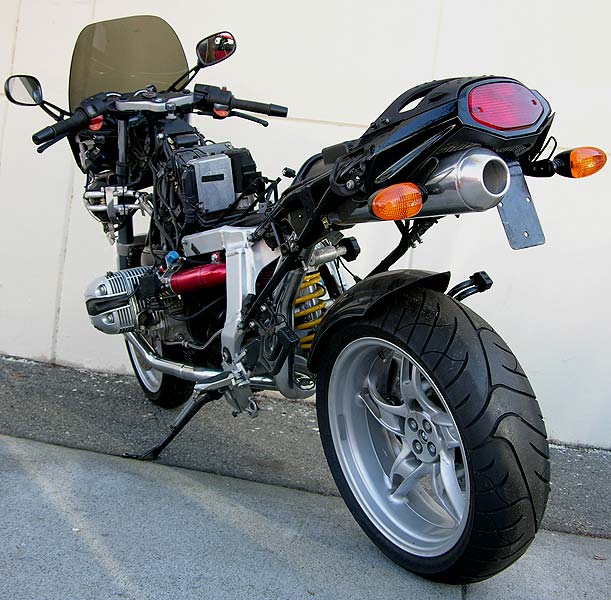
Here you can see the clean, logical, approach to the design. Unlike the stock exhaust or "Replica" systems this is a clean slate racing exhaust that just happens to be quiet due to it's Black Hole sound-cancelling technology.
For those of you working on your R1100RT/RS; R850/1100GS/1100R a pdf workshop manual.
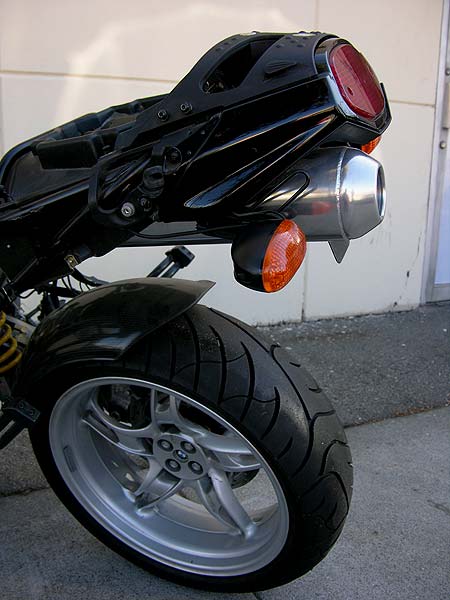
We provide a revised license plate holder that sockets into the same location as did the original exhaust assembly. The license plate holder and the pipe bolt together to form a rigid structure. New round caps replace older "snouts" on our first generation series of BMW Black Hole exhausts. All new 2-1 Black Hole Spyder Exhausts have round end caps.
The Cops Can Get Your Number
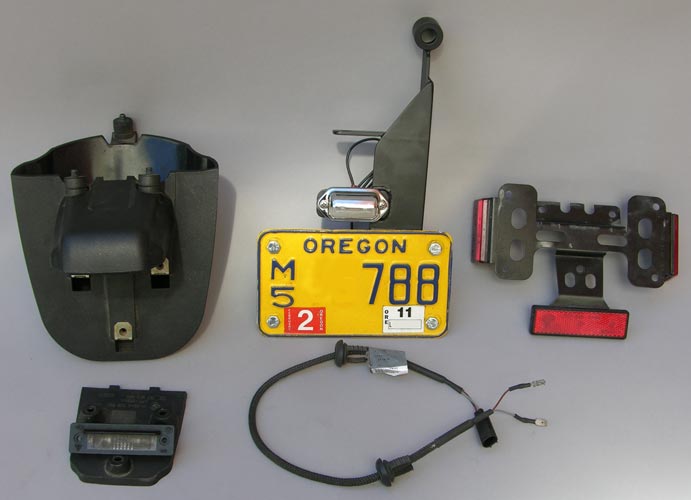
On the R1100S we proide a new license plate bracket that triangulates and locks in the high mounted exhaust. We do away with the OEM parts and provide a dual L.E.D. license plate light that plugs directly into your OEM wiring. No bulbs to burn out and the cops can read your numbers. To the right and left are the parts we do away with. There is no end to the stuff we have to make to keep people amused.
BMW's Japan

We ship exhausts all over the world...Customer writes: "Hello RB Racing, I received exhaust and replace STAINTUNE by Blackhole. Except one fitting problem such as merge collector joint was oval shape due to welding heat, I could easily fit the system. Of course I adjusted oval to circle, also licence bracket could be easily fit. Sound is much better than STAINTUNE for me. Weight is 6kg lighter than standard exhaust pipes plus STAINTUNE slip on. Appearance is better than STAINTUNE for me. Single pipe to muffler, single muffler and Silver ceramic coat which is painfully "American motor racing" for me, Japanese. I appreciate your product, your unique attitude with real passion or fighting spirit. I took risk from Japan and got return than I expected. Thank you, Keno."
Death Screw

When installing your new R1100S exhaust, first remove the left rear signal. The reason for this is that the screw that threads through its plastic holder will scratch the hell out of your LSR 2-1 Black Hole R1100S exhaust. We suggest you grind the tip of the screw flat so it won't scratch the pipe as you wiggle it either on or off its rubber-mounted dowel. Failure to remove the screw will result in some neatly symmetrical scratches on the outside edge of the Black Hole cannister. You won't see them till it's too late.
BMW IQ Test #1
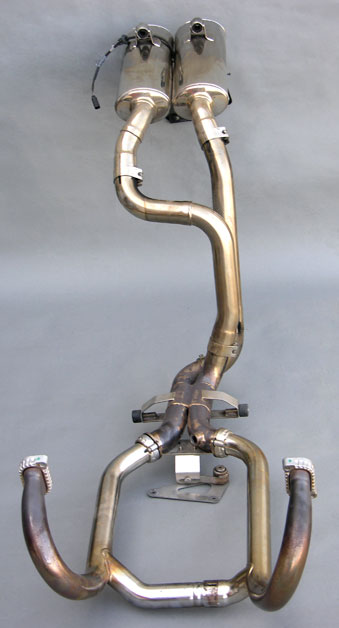
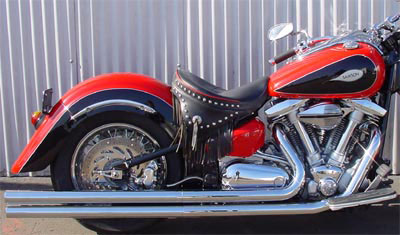
Compare the exhaust above which comes fitted on a BMW R1100S "Replica" with the Cruiser "Long Cannon" Samson exhaust on the right. The BMW has primary tubes about 76" long, starting out at 1 3/4" and half-way along the route they enlarge to 2". We haven't even added in the mufflers yet, which are another 17" long for a whopping 93" long individual primary tubes. No scavenging, no tuning, no velocity, just long tubes.
Now look at the Harley-type cruiser exhaust on the right. You know it is for looks and sound i.e. noise...Blatt! 56" long primary tubes 1 3/4" in diameter, covered by heat shields. You laugh at these, but praise your Replica BMW. Is there some sort of disconnect going on here? Some things, when hidden, just don't get into the decision making process.
Take a look at the RB Racing LSR 2-1 Black Hole Spyder R1100S exhaust. Primary tubes 1 3/4" diameter, 31 inches long, going into a hand-made merge collector, exiting at 2". Scavenging, high gas speeds, vacuum signals at exhaust ports. Is it any wonder that it works better? Anything would work better!
Check further down the page to see how we make your bike work even better in the intake and fuel delivery departments. It's an entire system.
BMW IQ Test #2
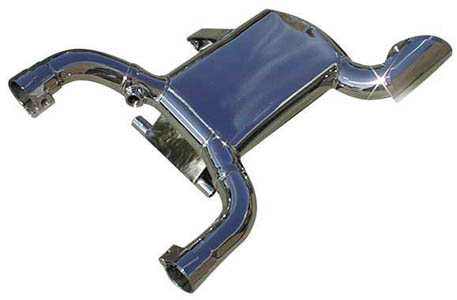
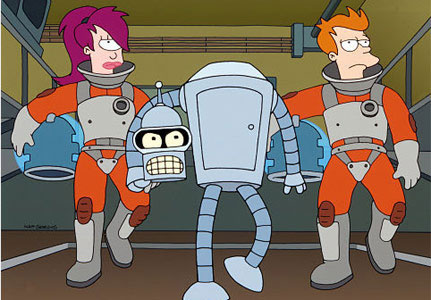
It's shiny and it costs $1200.00 and it sits under your bike. Sure doesn't have anything to with proper exhaust design or cylinder scavenging. Looks sort of like a decapitated robot from Futurama. Someone beat it with an ugly stick. If you see one report it to Homeland Security, it may have entered the country illegally.
New Cloisonne Tags
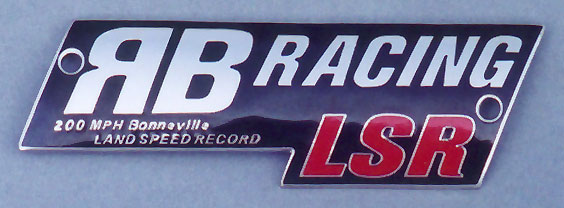
Like in the adage "The relentless search for perfection" we have upgraded the logos we put on our LSR Exhaust Systems. Previous tags were stamped and formed aluminum with silkscreened details. The new cloisonne tags are a precision die struck brass, nickel plated, with powdered glass fired in an oven then polished to a jewelry finish. These are direct replacements for our older tags and are available for US $20.00 via US Global Express (foreign) or Priority Mail (domestic US). They come with black headed rivets and are riveted in place with a light coat of high temperature silicone (Permatex 598B) behind the tag.
We don't do slip-ons
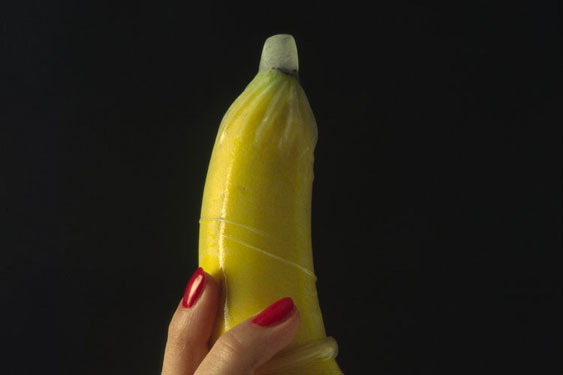
About every exhaust system manufacturer makes "slip-on" mufflers. Teflon coated die cast butt plugs full of kinky rivets and adorned in finishes to make your knees weak and your wallet flutter. Well, we don't just build things because you just might buy them...We build things that work, things without compromise, parts without limits. It all starts at the cylinder head and it ends where it barks. We don't do slip-ons.
R11...It all Starts at the Port
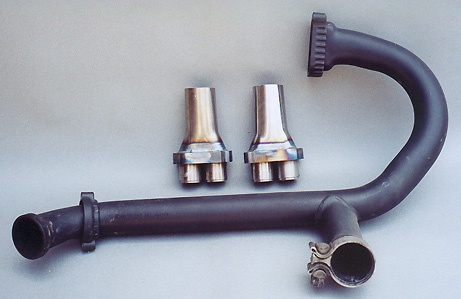
Stock R1100S header in black and RB Racing Black Hole laser cut and fabricated exhaust port flanges for both turbo and normally aspirated Black Hole 2-1 Exhaust. There was no way we were going to use the stock parts and make something that bolted onto the original primary tubes.
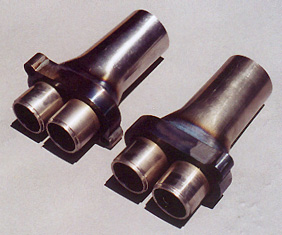
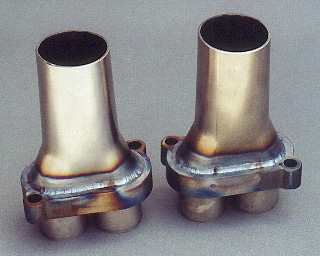
Machined parts, laser cut parts and fabricated parts...all to smooth out the exhaust flow. We got rid of the "dead" high pressure, low velocity no-mans land and sent the exhaust gases on their way in a more professional manner.
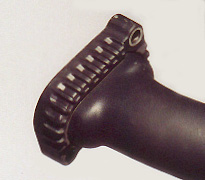
The oem part features a severe "bump" as well as a nasty mig weld on the inside of the flange...we smoothed all of this out. Wait till you see the rest of the parts as well as the other innovations that you can go Ducati hunting with. We take all of this very serious...it's not about selling parts. It's about providing real gains for a bike that's damn sophisticated to start with.
This snake "swallowed something" bump needs to be replaced. Adding some drop in spigots will not do a damn thing...and they have to be welded or flanged into the correct geometry. You still have to contend with a useless crossover and no effective collector. Best replace the whole thing at once.
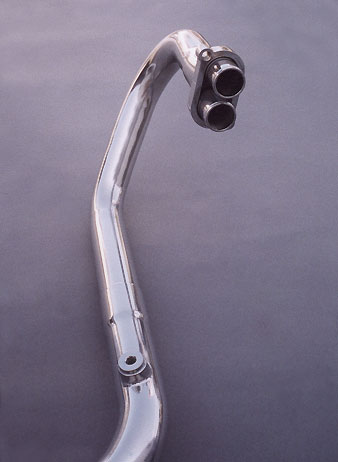
Unlike the earlier R bikes which featured three bolt flanges, these later models have a stainless steel sandwich gasket that surrounds the periphery of the port...our exhaust uses the oem gasket for sealing but adds the spigots to keep the port velocity high and to ease the transition into the 45mm primary tube.
The O-sensor simply screws into new location without any need to lengthen wires...and no, it has zero effect in this location as it still sees the combustion process of both cylinders. We build efi systems and have extensive experience (16 years) with twins and closed loop efi systems...on our world record holding RSR Efi systems we place the O2 port directly in the front exhaust port. For those of you who don't build this stuff we suggest you look into issues of heat when it comes to O-sensors and signal accuracy. Opinions are not facts. We deal in facts beause when you spend hundreds of thousands of dollars on development, setting records on all sorts of platforms and making bikes work way, way, beyond what others see as possible, you simply cannot operate without hard, firm, data. We have the data.
We build, we test and we know the base data. We do not import...we manufacture. We know engines. If you do not know engines you are just a parts peddler taking someones else's "guess" and trying to market it. Middlemen, jivers and pretenders.
Merge Collector
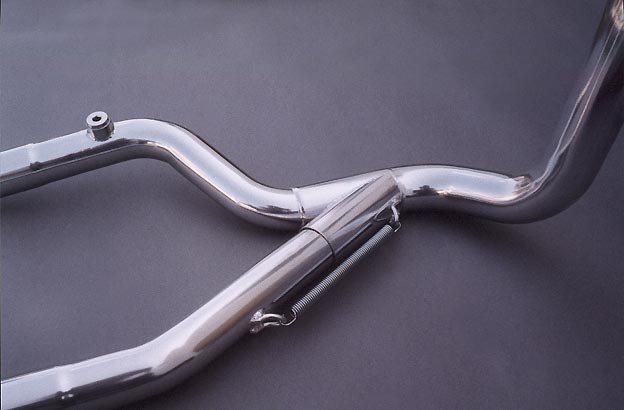
We use a fabricated merge collector that has a slip joint for the left cylinder primary tube. A merge collector is simply a precision mitered part that has a knife edged internal intersect of the two primary exhaust gas flows. This minimizes losses by keeping the velocity high and features an exit sized a few steps above the primary tube diameter. There are no humps or bumps for those of you who appreciate a properly executed collector. No clamps are used as this is a precision slip joint. The O-sensor simply screws into new location without any need to remove the bodywork.

The joint can be assembled with non-hardening Permatex 598B ULTRA BLACK if you so choose...If you want some form of additional seal. We usually assemble the silver ceramic slip joints with a light coat of silver Anti-Seize Lubricant, Permatex 133K which is good for temperatures from -65 deg F to 1600 deg F. Using the silver-colored anti-seize will make assembly easier as the ceramic can "grab" another ceramic surface. Use a rubber hammer to give a final tap to all slip joints. You might choose to use a small strip of masking tape to mark the final seat depth (measured by depth of each slip joint....1.75").
Make a Wish
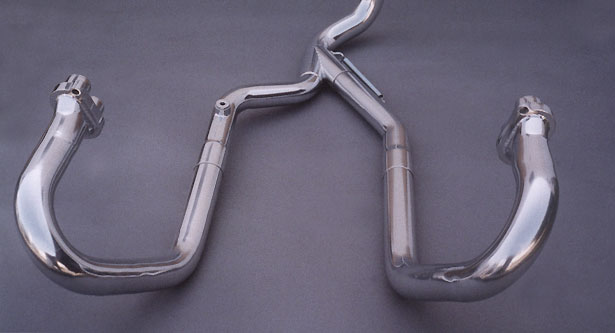
It's all made to do a job and the job gets done with torque and horsepower. Heat containing silver ceramic coating, merge collector, and hand formed, laser-cut spigot exhaust flanges. The oem system dumps into the catalytic convereter and does not have any form of collector. Black ceramic can also be special ordered.
The oem exhaust due to the catalytic converter has no "tuning" and has way too short primary tubes for a twin that has limited rpm potential. We have corrected this to give you a big gain in torque. Equal length primaries blend directly into our hand-formed merge collector.
We also eliminated the crossover tube which is always a band-aid device in exhaust system design. Cross-over tubes are excuses for lack of horsepower in bad designs...As people say "We are going for more usable power"....Bullshit! We also were not stupid enough to route the exhaust under the bike where it would get scraped on loading ramps and speed bumps.

We put a lot of tricks into this one, including a special high flow Black Hole Spyder Exhaust muffler section that cancels the sound but is specially matched to the larger pistons on the R bike. The 99mm pistons on the R1100S send bigger puffs of air down the pipe than does the 70.5 mm K1200RS/LT/GT series machines. The bike is absolutely quiet with near zero backpressure. As the speed increases the bike does not get noisier. Pure stealth. When we do something, we do it right.

We kept the exit gases as straight as possible instead of turning them immediately into a bend. A small detail but every bit of inertia helps. Notice the smooth transition into the 1 3/4" head pipes (45mm). BMW does this on their high end race bikes. As there are no telescopic forks we have plrnty of room to gain this advantage.
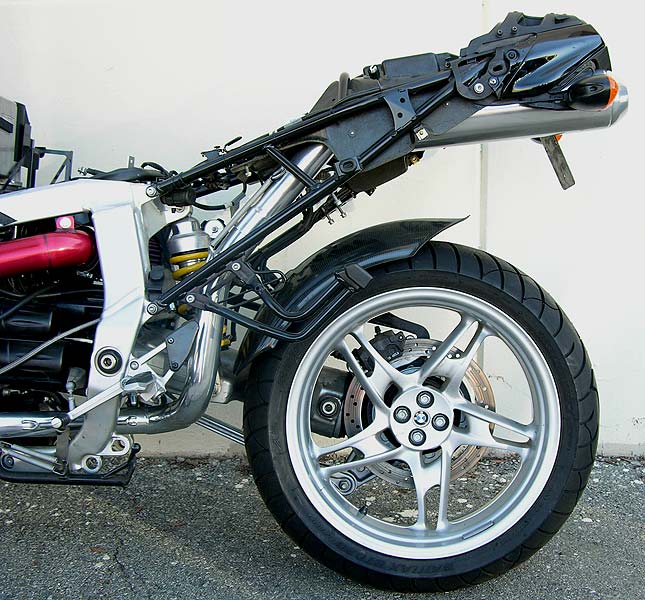
Springs are used on the final two slip joints...Left connector tube and on the tail section. No clamps are used on the slip joints, Slip joints are meant to be just that i.e. :slip joints", not squeezed to gether solid connections.
As for sound, it is really quiet and has almost no backpressure. Throatier than stock but it does not get noisier as the bike rpms...Black Hole Technology. The Black Hole Muffler section tucks tightly into the stock location under the tail section and exits the gases away from plastic body panels.
The stuff you Forget
No packing. No rivets to loosen. No discloration. No change in sound quality over time. No thin, poorly made parts that degrade, rattle, discolor or annoy you or others in extended operation. A complete fuel and exhaust approach to power.
Fuel and Intake System Upgrades
We have engineered an intake and injector / fuel system upgrade packages for the R1100/1150 models which increase the bike's potential beyond any "intercept box modification". Our 15 years of experience with fuel injection in which we actually build and code our own ecus, as well as build fuel injector test equipment, led us to engineer solutions for those who want to keep their air boxes and for those who wish to free up the entire system.
We can supply ecu chips. We can change fuel regulators. We can eliminate the oem inlet system completely.
Snake Oil
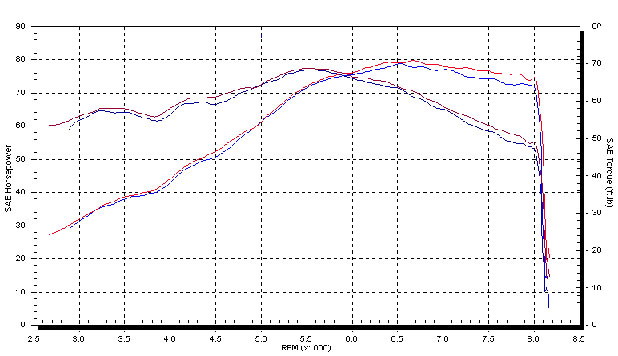
Graphs like these purport to show gains. We see nothing but statistical variation. DynoJet inertial dynos are optimistic compaired to eddy current designs. We used to tell Harley owners to put on a lighter rear wheel for horsepower gains.
As some of you might guess we don't exactly approach these issues from a "sell you a new widget" approach that others take, trying to squeeze some meaningless gain out of a slightly modified bad design. It's best to have an understanding of what needs to be done, then just do it. If you are thinking about: (1) Drilling holes in your air box; (2) Advancing your cams with 9 degree sprockets; or (3) Buying some silly inlet duct...Don't waste your money. Minor inlet changes do nothing. OEM camshaft timing has little overlap anyway due to emissions testing...advancing the cams only makes this worse.
You are dealing with closed-loop digital electronics with hard coded lookup tables. Piddling changes here and there do little or nothing. We use real world testing as well as sophisticated eddy current dynos to do our research, with an emphasis on the real world. You have to have an understanding of the electronics and the mechanical issues.
Real World

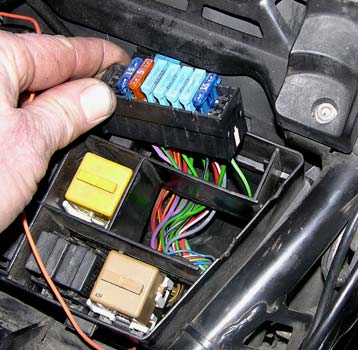
Monitoring your engine while riding is the best way to evaluate your bike. Our RSR Air Fuel Ratio Gauge is permanently mounted on your bike and is wired into your oil pressure switch, your battery negative, your O2 signal wire (Black), and to switched 12VDc. The best way to hook up the 12 VDc (orange wire and red wire) is to Scotchlock them to fuse location #1 (15 amp) on the green wire with the black stripe. You pop out the fuse tub to do this (tab on leading edge holds it in place).
A PDF on the gauge itself can be downloaded.
We do computer chip upgrades and in the case of our Turbos we change to a Bosch Billet Fuel regulator assembly as the oem regulator is not connected to manifold pressure. With turbos the fuel pressure has to track manifold pressure. We do all our real world testing before we do any dyno work. If you do not upgrade the fuel system the bike's hard-coded programming won't match the increased airflow. Loading on even an eddy current dyno like we have is not as accurate as real world testing.
Shop Manuals
For those of you who are not mechanically challenged and for whom the thought of paying another human being to work on your bike is off your radar we offer the following pdf format shop manuals: R1100S; R850C/1200C. We have noticed a certain, shall we say, penny-pinching in certain people we have encountered.
We have noticed a certain, shall we say, penny-pinching in certain people we have encountered.
Luke, I am your father
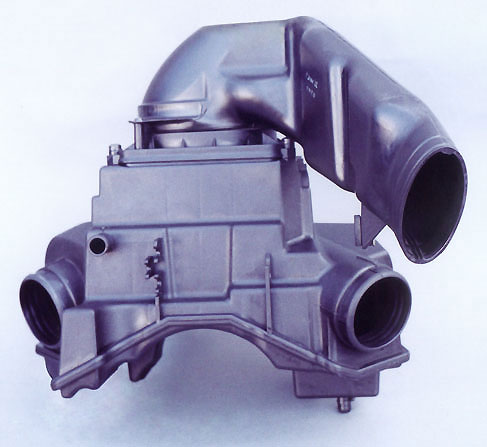
The dark side of the force, ominously hidden behind your battery, choking off your very breath, intertwined in subframes, ABS lines, electrical connectors and backed up by a coiled steel spring serpent should you try to wrest it from its realm. Sort of like a politician trying to hang onto office with his or her fingers in every pie.
A few wrenches and a couple of hours and the beast can be taken into direct sunlight where it can no longer strangle your bike. Place it in a cardboard box and put it on a shelf where it can lie in wait for the Restore to Stock religious fanatics.
120 Degree Hairpin Turn
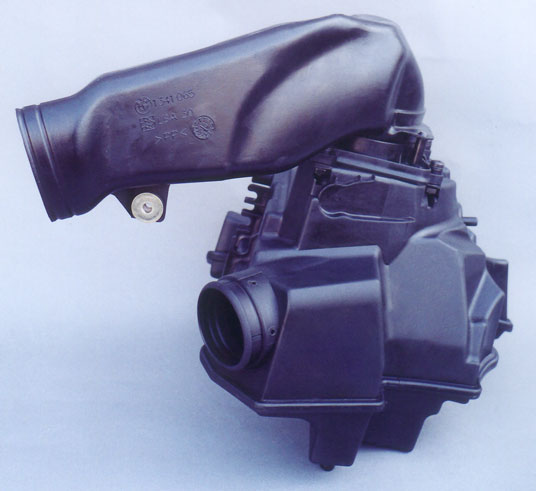
The air has to make its way via the front-mounted snout and then make an abrupt 120 degree turn to get to the airbox where it meets the next choke point...the air filter. Those of you in the HVAC business will know what this means.
96 Hp Dyson
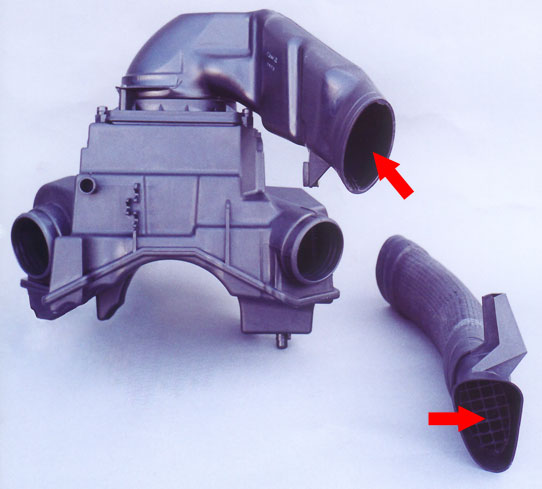
This clever attachment is where all the air comes in, a small triangular grated slot run through an oval heat blanket insulated tube enroute to the Death Star. In this case the passage leads to the trash compacting air filter which collects bugs and whatever else space debris you run into.
Any attempt to replace the inlet tract and keep the airbox is an exercise in self-delusion. You won't have changed a damn thing except minutely screw up your BMW Motronic calibrations which are based on ambient pressures which are, in turn, matched to your fuel pressure, injector characteristics and throttle angle calculations. If you don't alter the inlet radically, the injectors and fuel pressure and the exhaust, all in concert, you will just waste your money.
Round up the usual suspects

While we are putting on a new set of clothes and boarding a newer, faster R1100S, Homeland Security will be sending these non-combatants off to a detention facility where they will be held until their E-Bay appointed lawyer shows up.
One of our customers on seeing the R1100S air filter commented "That thing would strangle an old RD350!".
Stay tuned while we show you how to make the R1100S soar as it was supposed to. Real gains. Real Parts. No Half-Ass approach. Piddle if you so choose, buying parts from different vendors, all the while the die is set and the limits that were designed into the system remain there, like Darth Vader, suffocating your horsepower.
What Lies Down Below
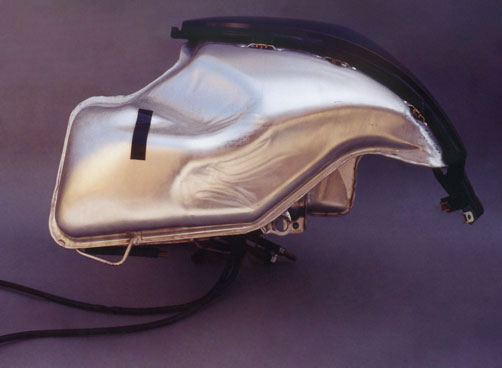

You went out clear headed one night and woke up the next morning to find out what your BMW looks like without makeup. Beauty is in the eye of the beholder as they say. As the tank droops low on each side there is a fuel line that loops from the left to the right side so the fuel pump which hides on the right side can access all the fuel in the tank.
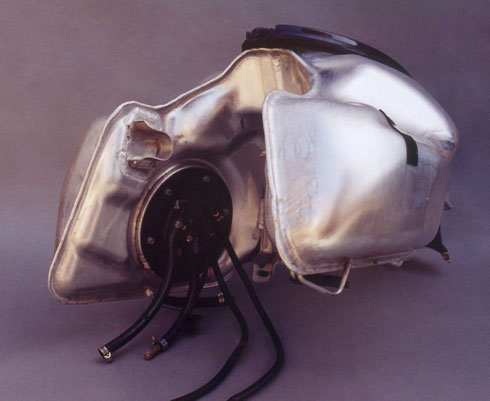
Feed, return,overflow and vent lines. The return line is "open" and fuel will flow if you don't plug it. The feed line which runs off to the regulator and injectors does not need to be blocked off. The fuel pump is hiding behind the black circular access plate. You can download a PDF manual to see whats involved in removing parts from your R1100S.
"Rollin' down the Imperial Highway
With a big nasty redhead at my side..." Randy Newman
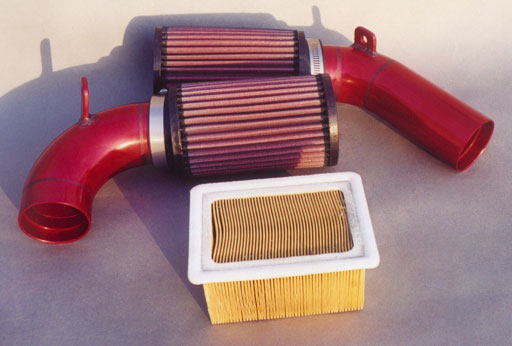
Out of kindness we photographed the oem filter close to the camera where it looks bigger than it actually is. Appropriately sized for a lawnmower, it strangles your R1100S. When those 99mm pistons take a gulp of air they have to breathe though a white picture frame masking a world of oxygen fresh air. We race things so we simply decided to get rid of the restriction and put 560hp worth of air filters and some machined ram inlet tubes in the place of the oem airbox. We say 280hp because we use one of these filters on our race turbos that put out 280hp @ 12psi...above this we take the damn filters off because after this they start limiting airflow. This is a ZERO RESTRICTION AIR SYSTEM.
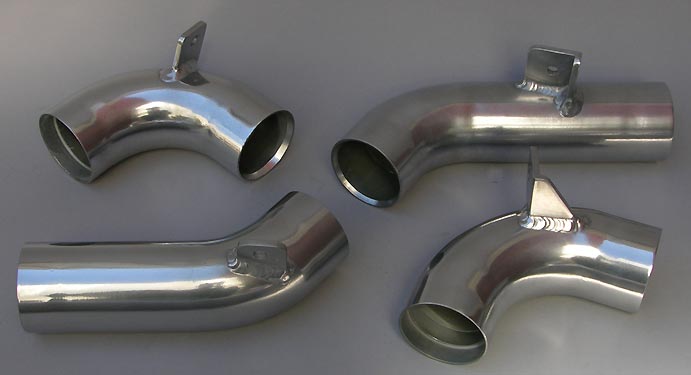
We made these in red for awhile, then grey, and now in silver ceramic. It's a fashion show. You don't have a choice...these days it's ceramic silver. We get bored easily. Securely mounted and positive o-ring sealed.
Black Hole Exhaust + More Air + More Fuel
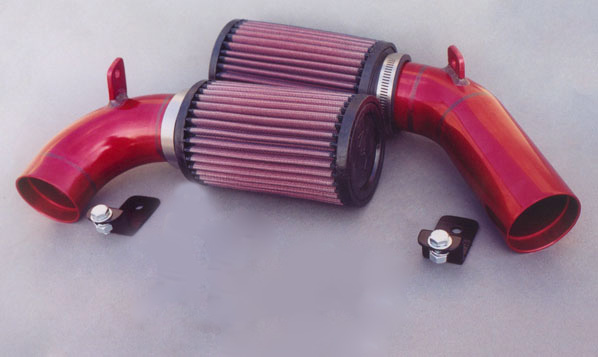
You can deal with a chipmaker that doesn't make exhausts, or you can deal with an exhaust maker who doesn't do fuel, or you go to a parts peddler that will sell you a drop in K&N filter, or you can deal with one supplier who actually manufactures the complete product. You can discuss it to end's length and compare this and that but, in the end, you are going to have to face the fact your system has limits. We talk to people all the time who are trying to turn lead into gold. It just isn't going to happen.
Why is one tube longer than the other? Probably because we were trying to save material. Maybe not. Think about it.
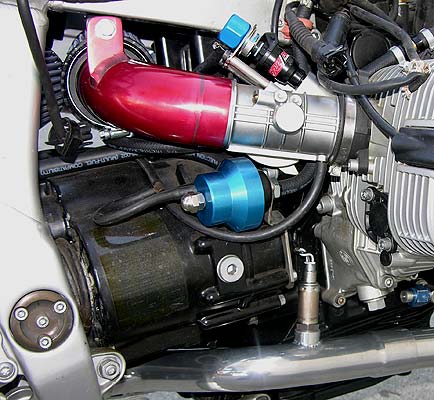
We can replace your fuel injectors with higher performace items with different spray patterns. We get rid of the oem fixed regulator and give you an adjustable regulator that we set up to add more fuel as manifold pressure increases. Or you can keep your stock parts...It's up to you.
New Bosch Billet Fuel Regulators
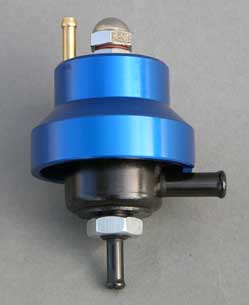
We have improved our fuel regulators by using a Bosch Billet Adjustable Regulator that we cnc machine. We use these in all our fuel system upgrades as well as with our turbocharger systems. More precise and better seats with a hardened and ground ball and socket design. Holds pressure better for smoother operation and more reliable low battery condition starting.
Part Number 06-1023 $195.00. Comes with integral 12mm x 1.5 jam nut for easy mounting.
You can adjust your fuel pressure without any need to remove anything from the bike. We have a precision gauge for this for $75.00 if you do not have access to one. We set the fuel pressure for you at RB Racing.
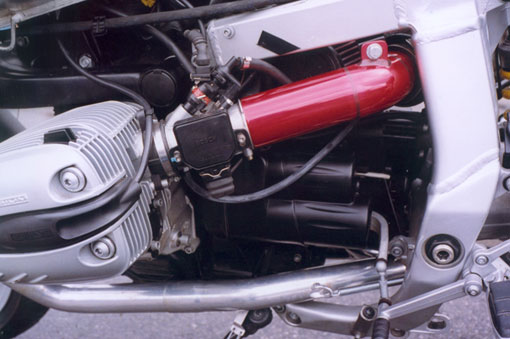
We provide billet machined ram air tubes that precision socket onto your oem throttle bodies with an o-ring seal. We provide all mounting hardware and new fuel lines and fittings.
BMW Parts are Friggin Expensive

If you break one of the plastic fuel injector feed caps you get to buy the entire Black Mamba fuel rail package shown above. After installing a few 00-6007 Packages for customers and prying the hoses off these plastic parts we decided to replace the whole mess. Now you just remove the oem fuel rail and pressure regulator intact and replace them with the prefabricated hose and cnc machined, anodized and laser-cut assembly we provide. We don't want you or your dealer to wrestle with the damn hoses and plastic parts. It's our money and time but we haven't increased the package price.

Testing, testing, testing. Some people are selling, selling and selling...but they never test. People are in a hurry. They are full of advice. They have read every magazine and studied every test and visited every forum and even made spreadsheets to optimize their decision process. We just do it.
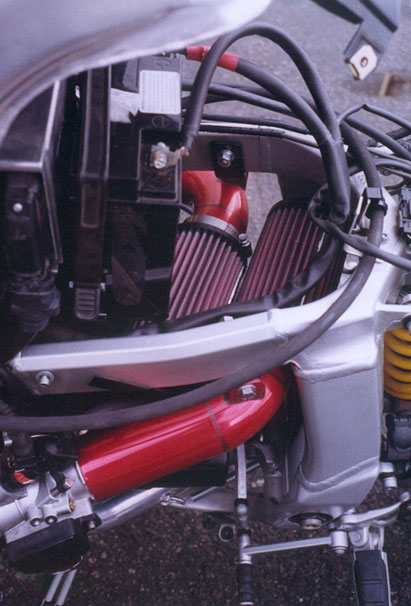
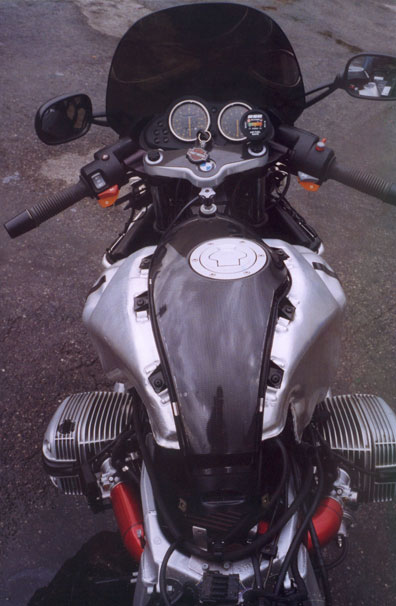
Pictured to the right above and in the picture below is our RSR Air Fuel Ratio gauge which comes with the 00-6007 option that you use to set the system. This is mounted in line of sight with your tachometer. In the picture to the left you can see the way the ram air tubes nestle together with their zero restriction K&N filters.
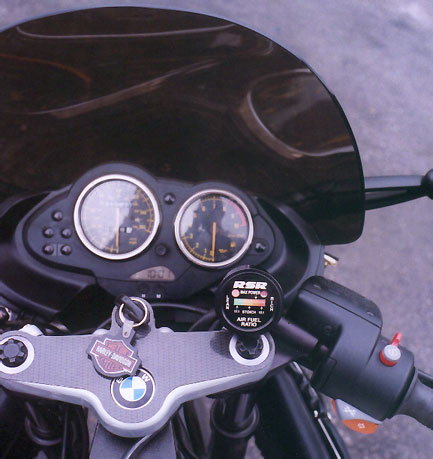
To extract the maximum from your bike at full throttle you need to be able to monitor your air fuel ratio. The RSR gauge is waterproof and is visible in daylight and dims automatically at night. In closed loop operation the light will try to center around stoichiometry.
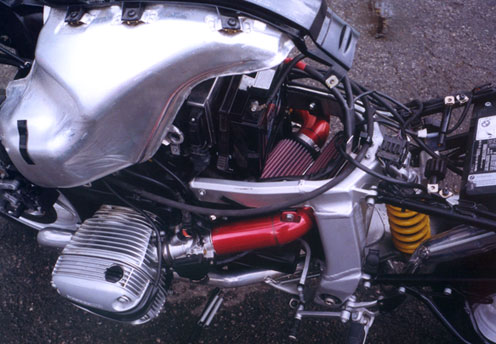
Zero restriction inlet ram tubes, high performance injectors and a Silver Ceramic LSR 2-1 Black Hole Exhaust. The most advanced exhaust sytem that you can purchase. The best inlet system you can buy...and a RSR Air Fuel Ratio meter to monitor and tune your fuel curve. Nothing even comes close to the technology.
RSR R Series Clutches
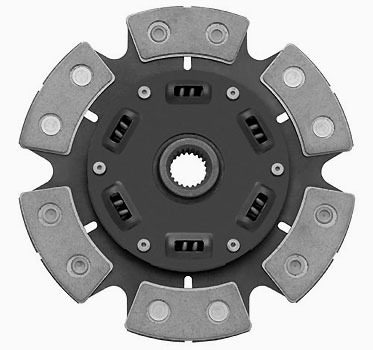
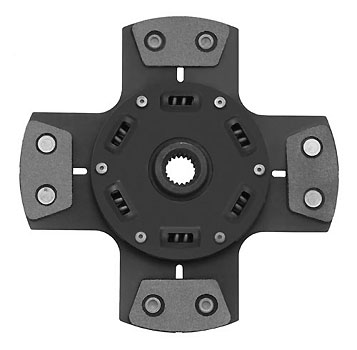
Another weak point in R Series BMWs is the clutch. If you are performance oriented, or if you simply want a better clutch that adresses the OEM design's shortcomings, we have the solution. New sprung hub designs address these limitations.
Logic
R series Oilhead BMWs are a logical evolution of the earlier air-cooled powerplants but they remain largely a fixed equation of bore, stroke, compression, piston and camshaft design. All the wishful thinking in the world isn't going to magically transform the beast. We talk to people all the time who have spent a lot of money on exhausts, "chips", air filters, engine work and assorted oddities like minor airbox modifications....and they got little or no gains.
What we have done is alter the three elements of the equation that we have control over i.e. the inlet system, the fuel delivery system, and the exhaust system and optimized these and left the fixed parts of the equation in place.
Another element of the equation is the closed loop Motronic system which, unless you have an understanding of closed loop "tuning" issues, will cause you nothing but trouble because the approach is completely different from what everyone would think is right. You are not dealing with a carburetor and your target points are not the same. Wishful twiddling of BMW's carefully crafted plan will not change things and will most often represent a step backwards.
Logic has little place in today's consumer driven society. It is a casualty in our desire to scramble over the other person's back to a higher rung on an imaginary ladder.
Angst

The agony of decision making can drive a poor consumer insane..."What is the best?"...".."How does it compare?"..."What will I get, what will I gain?"..."When can I get it?"..."Can you put the muffler in the middle?"..."Will it work with my $400.00 chip?".."Can I get it in Black?"..."Can I talk to someone who has one?"..."How long have you been in business"..."I've never heard of you"... "How black is the black?"..."Why haven't I seen these before...where can I see them?"..."My bike is in the shop and I have to have the pipe by Friday or I'll lose my slot!"..."Is the silver as shiny as chrome?"..."Why don't you use dual mufflers?"..."Will it void my warranty?"..."Can I use the muffler I already bought?"..."Can I get titanium and carbon fiber!"..."I want 150hp!".
Right brain, left brain. Fear of rejection. Fear of being different. Social standing. It's all too much for most people to deal with. The Black Hole Spyder...it's different...It works.
If you wish avoid any decision and stay right where you are, just take the Blue Pill and doze off to the mantra " no more taxes, no more draft, no pesky reality checks...". If the journey for truth and power excites your spirit, take the Red Pill.